
Small Task of Great Importance
Form validation design is as tricky as a hyperactive squirrel. It’s a tiny thing that can steal your lunch (both a squirrel and dodgy form validation). No matter how boring it is for us designers – we need to follow certain rules to make the form validation our strength rather than weakness.
And believe me or not I needed to see results of A/B tests years ago to really buy the concept of spending lots (relatively) of time on the design of form validation.
As a convinced follower of the idea of the importance of form validation, I welcomed the opportunity to share my experience in the great Design Modo!
“A couple of years ago I saw Twitter’s form validation for the first time and I was absolutely amazed. User Interface nerds among you probably know what I’m talking about. At the time we were almost jumping with excitement.
The discrete charm of well-designed form validation in Twitter’s forms was absolutely seductive. Informative error messages popped out right when I’d made an error, immediately eliminating irritation. “Inline validation” helped me understand what was going on right away. I could feel that this simple form was trying to have an actual conversation with me. That was a revelation! In the end, I didn’t have to wait for a reload of the whole page to check if the form was filled in with the right data.
This experience completely changed my approach to the design of forms. It helped me understand that form validations are meant to have conversations with users and guide them through the difficult times of errors and uncertainty.”
Read the whole article on how to design a form validation.


